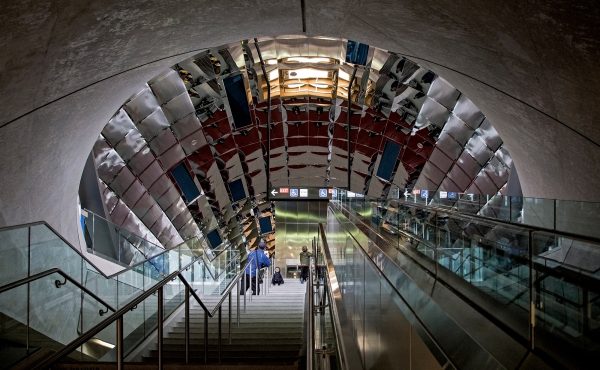
The Gibraltar Point Lighthouse, 1909

Hop on your bike some day and head over to Hanlan’s Point. As you exit the ferry, ignore the statue of one of the world’s great rowers, Ned Hanlan, and don’t be tempted to read the plaques off to the right about the former baseball stadium and one of the greatest baseball players of all time, Babe Ruth. That’s all recent history. Ride down the road towards what is oddly named “Gibraltar Point†(it’s a sandbar as flat as a pancake), and as you round the corner heading left and east, keep an eye out through the thick trees and brush to your left. Hiding in the foliage is the real story about this part of the island — one of maybe two pre-1810 buildings in the old City of Toronto still in its original location, and one rich with tales about murder, storms, and shipwrecks.
It is, of all things, a lighthouse – a lovely, picturesque, grey limestone building, about 75 feet high, with an old red door and a big iron key and a red cage for the light on top. In fact, it’s the oldest surviving lighthouse on the Great Lakes, and the second oldest surviving lighthouse in Canada. And in a few weeks, lighthouse junkies from around North America are coming to celebrate its 200th anniversary.
Torontonians generally don’t even know the lighthouse exists, but that’s not particularly surprising. We remember what means something to us — what helps makes sense of our place. Today, lighthouses symbolize the Maritimes or Lake Superior — places we think of as defined by big water, and by sometimes treacherous journeys over it. Toronto hasn’t much thought about shipping for about 40 years now. And without any context of heavy lake travel, lighthouses have slipped from our point of reference. When I think of Lake Ontario, I think of empty expanse dotted with a few small pleasure boats. I don’t think of nervous men on ships trying to make their way around the shallow shoals of the island and through sandbars (not concrete “gapsâ€) into Toronto harbour.
Gibraltar Point Lighthouse is forgotten, I would argue, precisely because the era it defines, not to mention nearly all of its original landscape, has been lost. It belongs on a red cliff in P.E.I. – somewhere with wind and water and space — not surrounded by trees and bushes with no water, and no inspiring views, in site.
But this is what makes that marooned stone lighthouse so important to this city today. The lighthouse is our very rare touchstone — a portal, if you like — to a town not even yet called Toronto.
When the lighthouse was constructed in 1808-09, Toronto was the Town of York, a tiny settlement of about 650 people, clustered by the lakeshore east of today’s St. Lawrence Market, and bounded by forest north of Queen (then Lot Street). With “roads†little more than cart tracks through often impassable mud, travel was preferably by water. South of Front Street, a couple of wooden piers stretched into the water. Ships were the life-line of the town. The lake was the way in, and the way out.
Without a lighthouse, the Town of York was like a city today without a signed highway. More than that, it was a community that put its travellers, and itself, at risk. Very shallow shoals stretched a good ways out into the water from the island — a fact noted in early maps of the harbour, but also by much later photos of Victorian kids standing up to their knees in water far off Hanlan’s Point. Getting into Toronto’s harbour was no easy trick in good weather and in light. In darkness or in storms, Toronto became invisible. Even after the lighthouse, more than a few ships, like the Monarch in November of 1856, found themselves wrecked on Toronto’s shores. And more than a few epic moments of heroism resulted from rescue attempts by the equivalent of today’s firecrews — men paid to launch rowboats into violent storms to save lives.

Shipwreck of the Monarch, 1856
So came the lighthouse. Probably unlike any other building in York at the time, the vast majority of which were made out of wood and not even brick, the lighthouse was constructed of hand-quarried stone brought by sailing ship from Queenston, near Niagara Falls. With walls nearly 2 meters thick at the base, it was built to last against harsh lake storms, and constructed at great government expense. Next to it was built a two-room lighthouse keeper’s cottage, and the first keeper, J.P. Radenmuller, became the first year-round resident on the island. It was he who famously disappeared in 1815, perhaps murdered by soldiers from Fort York. And it is he who perhaps still haunts the site today.
When built, the lighthouse was only about 25 feet from the lake. Today, given the continued accumulation of sand from the bluffs, the shore is about 300 feet off.
In fact, given all of the landfill, the coming and going of residential development, and the building of a water treatment plant on the island, there’s not much else out there, besides the lighthouse, that hasn’t changed in 200 years.
The stone structure’s adaptation to changing times is a fascinating story. A whale oil, then coal oil lamp was electrified only in 1917 — and then changed to green in the 1940s to distinguish it from the modern lights of the city beyond. In its early days, the lighthouse was an icon of the city — the first and last sign of humanity to travellers, and a part of an early warning system (through flags flown from its top) of ships coming into town. Raised to its current height by more stone in the 1830s, and surrounded by barren land into the twentieth century, it is today invisible to the city through the trees of the island. It’s two room keeper’s cottage was joined by a two-storey house in the 1830s, then much later by a telegraph station.

Lighthouse homes, 1910
At the end of the 1957 shipping season, the lighthouse was declared surplus by the federal Department of Transportation. The lamp was extinguished by Dedie Dodds, the last of a long line of lighthouse keepers who had helped form the nucleus of a growing island community. Threatened with demolition (what to do with a useless old stone lighthouse in the 1950s?), Gibraltar Point Lighthouse was transferred to the ownership of Metropolitan Toronto, who invested in its restoration. Then, in the 1960s, the former homes of the lighthouse keepers were demolished, and the surrounding land — once off limits to the public for reasons of security — was integrated into Toronto Island Park.
There it still sits today, an old stone lighthouse, cut off from the water and from much of its past, but still there to help us re-imagine a very different island, and a very different Toronto.
Head out there on Saturday July 5 to help celebrate its 200th birthday. Festivities begin at 11:00 am.
top hoto from Toronto Archives, Fonds 1231, Item 1015b; bottom photo Fonds 1244, Item 6
– – – – – – – – – – – – – –
Gary Miedema is a historian with Heritage Toronto and a regular contributor to Spacing. He is also the author of For Canada’s Sake: Public Religion, Centennial Celebrations, and the Re-making of Canada in the 1960s (McGill-Queen’s University Press, 2005). He is also a Research Associate at Victoria College, University of Toronto, and teaches in Ryerson University’s School of Continuing Education.




19 comments
What is the other possible pre-1810 building still in its original location?
I wonder if a new lighthouse, as a look-out point, should be created on the island or in the Portlands development. It would be a great thing to see on the waterfront. It could be a an iconic building if done right.
Cool! Love everything about the Islands since they are so unique to Toronto. More should be done to encourage people to visit them – like allowing transfers on a TTC fare onto the ferry.
Didn’t know about the lighthouse before but I found a great aerial image of it:
http://snurl.com/2q25x
Here’s another lighthouse in Toronto: http://www.torontohistory.org/Pages_PQR/Queens_Wharf_Lighthouse.html
The other building may be an old log house found within an existing house in Riverdale on Broadview Avenue, although not confirmed.
There’s also this one, at the end of the Leslie Spit:
http://www.rudyalicelighthouse.net/OntLts/TorHrbr/TorHrbr.htm
(And a little map of/links to the lighthouses in Ontario: http://www.rudyalicelighthouse.net/OntLts/westont.htm)
I wish the citizens living on the island would give up their “property” so that the rest of the population could enjoy the island as a park.
I think you’re trolling again George, but I’ll bite: I go to the island all the time and have no problem enjoying the island as a park. The two tiny (and “cute” and etc adjectives) communities are uniquely Toronto. People living in “the park” give the place an energy that most parks don’t have. In fact, we ought to promote this more, and maybe add in a few more “small town” amenities.
And there is ample area on the island to feel alone and away from everything. Anybody who ventures away from Wards or Centre island knows this.
trolling?
yes, trolling. http://en.wikipedia.org/wiki/Troll_%28Internet%29
it was so nice for those few weeks not to see Sawison’s poorly written and ill-informed comments. But all good things come to and end….
But since he’s asking for it, half the island already is a park and I don’t know why folks like George seem to be bitter about the small community that lives there. Maybe George should give back his house so that the original people of this country could enjoy the land as they see fit.
(glib comments deserve just as glib answers).
I’m with Shawn. I think the cottages on the island give it much character, and the history of cottaging on the island is long and rich.
And Rebecca’s right. The owners of a home on Broadview north of Gerard were renovating in the 1990s, I believe, and found old log walls inside their home. Turns it there was an original log cabin contained in the heart of their house. Talk about a find.
The other pre-1810 building that quickly comes to mind is the Scadding Cabin on the CNE grounds. But it was moved from the edge of the Don River in the 1870s.
lief>SAWISION is the correct spelling.
Didn’t Bob Rae have something to do with a 99 year lease that was extremely controversial? Don’t the “island residents” seem to feel that they have dominion over the rest of central Toronto regarding the island airport and the docklands?
“freedom of expression” is still a right in this country, isn’t it?Or would you prefer to change that?Just asking
Yes, I still have my right of “freedom of expression” to call you out on your regular string of cynical and misinformed comments. I’d like you to go away so decent, intelligent conversations could happen. I’m just doing what you do, but probably have more support behind me.
Face it. These days, there’s less and less of that kind of “rest of the population” who’s truly hung up over those Wards Island squatters-cum-residents getting in the way of their “park enjoyment”. Just as there’s less and less of that kind of “rest of the population” who object to Pride celebrations on objectionable-immoral-lifestyle grounds…
My six-year-old heard one of Fort York’s “soldiers” tell the tale of poor old Radenmuller. If the weather’s nice, we’ll sail over next Saturday to check out the anniversary.
What I like about this site is the generally high level of discourse but sometimes it gets a bit Stalinist. Unless you want this to be a boring monoculture skip the personal attacks.
Regarding the comments by george sawision, let’s start with, the people living on Toronto Island ARE citizens of Toronto. Anyone living in Regent Park or Rosedale, Parkdale or The Beaches couls choose to move there. Anyone living on the Island might choose to move to Kensington or Mimico. This diviseveness, creating an “us against them” mentality, is the sort of thing that encourages bullying, from the classroom to the boardroom, the ballot box to the battlefield.
Next, the record numbers of day-tripping visits to the Island were set way back in the 1920’s, when there were close to fifteen thousand folks in residence on the Island. this was a time when it was possible to have your choice among several ice cram shops, dozens of restaurants, several hotels and dance halls. By the 1950s you could catch an air conditioned movie or drop into the bowling alley. In other words, there was tuff to do.
The idea of ripping down the hand building one gigantic mega park came in the era when the Gardiner Expressway was being built, and they wanted to tear down Fort York because it was in the way. Cooler head eventually prevailed in that case, and the highway has a mild curve around the Fort.
The idea that parks could be scattered all over the city just wasn’t something that the mega developers wanted to hear. For them, a park was going to be a place that you had to drive to, or take transit to get to, and that was the only way it could be.
Nowadays, with the green shift and the “shop local” mindset growing, the idea that people could actually live adjacent to a park surely shouldn’t be seen as such a bad idea.
My favourite islands idea was that bike bridges be built at each end something like the one at Humber Bay so that you could bike or jog all along the shore from Humber to the Beaches.
It is remind me about the place where I live when I was young. It’s my favorite island and I uses to walk near by the clift